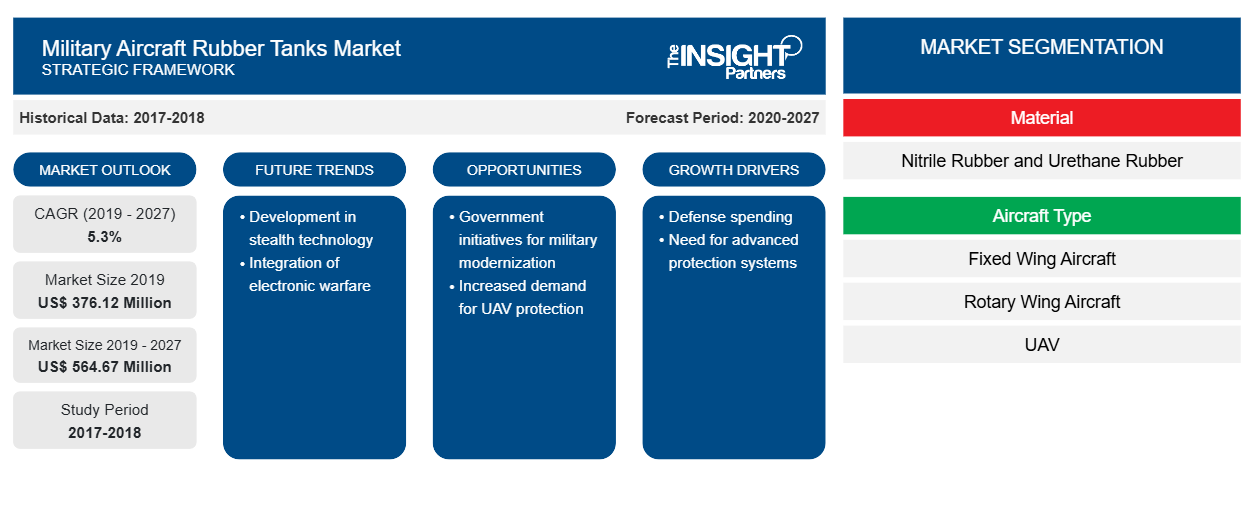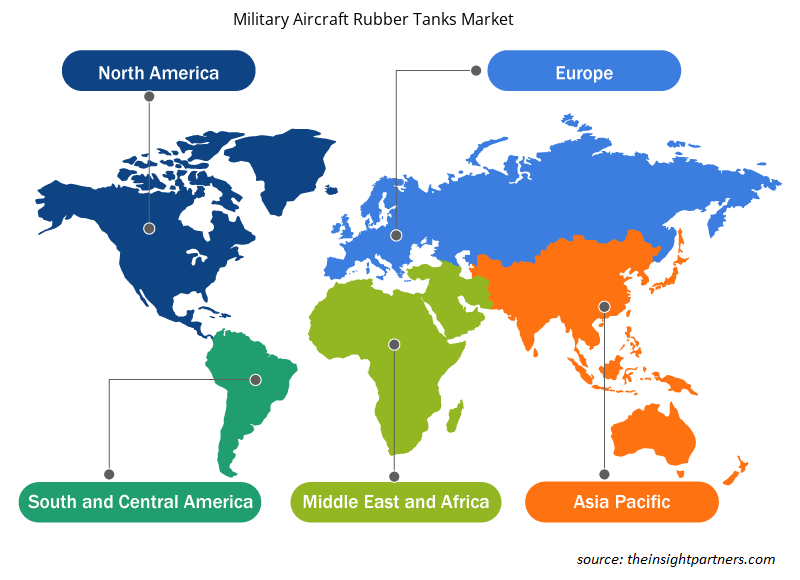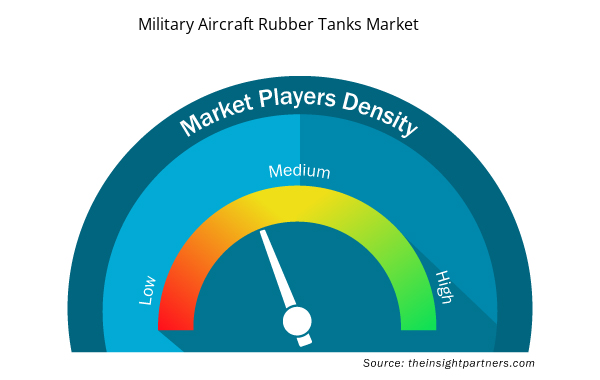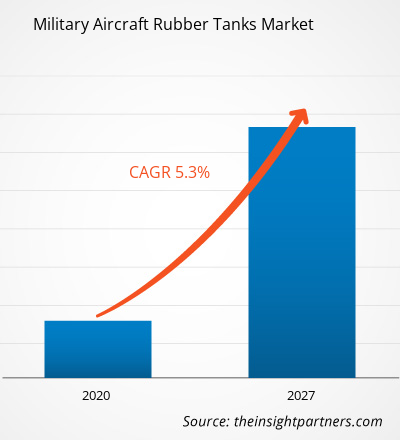The military aircraft rubber tanks market was valued at US$ 376.12 million in 2019 and is projected to reach US$ 564.67 million by 2027; it is expected to grow at a CAGR of 5.3% from 2020 to 2027.
Military and defense sectors are heavily investing in advanced technologies to strengthen their capabilities with advanced war aircraft. Companies in countries such as Russia, the US, and France are developing advanced aircraft for the global market. New military aircraft such as Dassault Rafale, F-35, and Saab Gripen are dominating the fixed-wing aircraft demand. Rising trade agreements between major countries such as Russia-India, Russia-China, and US-UAE regarding advanced military aircraft are supporting the market growth. Developing nations such as India, China, and Indonesia are strengthening their military aircraft stock due to rising border clash with neighboring countries. The rubber-based self-sealing fuel tanks are necessary components in advanced military aircraft. Advancements in army machines such as increased bullet size have the importance using rubber in fuel tanks as it quickly prevents the leakages. Further, the growing need of flexible fuel tanks to enhance fuel storage capacity and utilize spaces in wings, pylons, etc., is augmenting the market growth. The manufacturing companies such Magam Safety Ltd and Fuel Safe Systems are introducing advanced solutions for end users; the new products provide protection against 30mm bullet penetration.
Customize This Report To Suit Your Requirement
You will get customization on any report - free of charge - including parts of this report, or country-level analysis, Excel Data pack, as well as avail great offers and discounts for start-ups & universities
Military Aircraft Rubber Tanks Market: Strategic Insights

- Get Top Key Market Trends of this report.This FREE sample will include data analysis, ranging from market trends to estimates and forecasts.
You will get customization on any report - free of charge - including parts of this report, or country-level analysis, Excel Data pack, as well as avail great offers and discounts for start-ups & universities
Military Aircraft Rubber Tanks Market: Strategic Insights

- Get Top Key Market Trends of this report.This FREE sample will include data analysis, ranging from market trends to estimates and forecasts.
Impact of COVID-19 Pandemic on Military Aircraft Rubber Tanks Market
The COVID-19 pandemic situation has hampered the economic growth of almost every country. It has severely impacted the international transportation, which has had deeper effects on the commercial aircraft market. However, military aircraft industry has witnessed low impact of this downturn. Moreover, the hampered economic growth of countries has led to several months delay in the process of purchasing military aircraft. The military aerospace industry continued their operations with certain preventions set by the nation’s government but at slower speed. The lowered capacity of military aircraft manufacturers for a certain period hampered the production targets owing to lower staff availability on floor and restrictions such as physical distancing. In October 2020, Boeing, in its Q3 delivery report, stated decline in military aircraft deliveries by the count of 54 in September. Lower production rate of aircraft lowers the sale of associated components and technologies. This has hampered the military aircraft rubber tank market.
Military Aircraft Rubber TanksMarket Insights
Rising Adoption from Developing Nations Fuels Growth of Military Aircraft Rubber TanksMarket
Although, strengthening defense aircraft incurs huge economical cost, it is necessary for each nation to improve their defense systems for better protection against uncertain events, such as war and terrorism. Hence, each country is concerned and eager toward the deployment of advanced defense systems, such as aircraft, navy, and ground machineries. Military aircraft play major role in surveillance, instant attack, war supporting strategies, and others wooing to which each country is focusing toward its development. Significant growth in economy of developing nations is supporting the development of military aircraft sector. Additionally, rising pressure between country boarders such China and India is further creating opportunity for the market growth. For instance, in October, 2020, The Russian Helicopters holding company has awarded to deliver more than 120 helicopters for China amid India’s standoff with China. Among these 120 helicopters, 18 arecombat helicopters equipped with self-sealing covers for fuel tank. Similarly, in October, 2020, Afghanistan announced the upgradation of their military aircraft with new self-sealing technology. The new crashworthy fuel system is getting installed at MD 530F Cayuse Warrior light attack helicopter to improve the support for allied operations. Such increasing concerns of developing nations toward the deployment of advanced defense systems are creating lucrative opportunity for the market players to offer advanced solution at affordable cost.
Material-Based MarketInsights
Based on material, the military aircraft rubber tanks market is segmented into nitrile rubber and urethane rubber. The nitrile rubber segment held a larger market share in 2019.
Aircraft Type-Based Market Insights
Based on aircraft type, the military aircraft rubber tanks market is further segmented into fixed-wing aircraft, rotary-wing aircraft, and UAV. The rotary wing aircraft segment held the largest share of the military aircraft rubber tanks market in 2019.
The players operating in the military aircraft rubber tanks market focus on strategies such as mergers, acquisitions, and market initiatives to maintain their positions in the market. A few developments by key players are listed below:
In November 2019, Meggitt PLC signed a six-year contract with the Defense Logistics Agency (DLA), Philadelphia, for the supply of fuel bladders to the F/A-18 Super Hornet, V-22 Osprey, and CH/MH-53 Super Stallion. The company’s fuel bladders comprise innovative polyurethane material and confer lightweight solution with long life.
In September 2019, Magam Safety Ltd. unveiled a self-sealing flexible fuel tank that prevents fuel leakage caused by ballistic damage following the penetration of up to a 30-mm-bullet. These flexible tanks are suitable for multiple applications including helicopters, UAVs, and battle tanks. The self-sealing fuel tank system had been unveiled at the DSEI arms show in London.
Military Aircraft Rubber Tanks Market Regional Insights
The regional trends and factors influencing the Military Aircraft Rubber Tanks Market throughout the forecast period have been thoroughly explained by the analysts at Insight Partners. This section also discusses Military Aircraft Rubber Tanks Market segments and geography across North America, Europe, Asia Pacific, Middle East and Africa, and South and Central America.

- Get the Regional Specific Data for Military Aircraft Rubber Tanks Market
Military Aircraft Rubber Tanks Market Report Scope
| Report Attribute | Details |
|---|---|
| Market size in 2019 | US$ 376.12 Million |
| Market Size by 2027 | US$ 564.67 Million |
| Global CAGR (2019 - 2027) | 5.3% |
| Historical Data | 2017-2018 |
| Forecast period | 2020-2027 |
| Segments Covered |
By Material
|
| Regions and Countries Covered | North America
|
| Market leaders and key company profiles |
Military Aircraft Rubber Tanks Market Players Density: Understanding Its Impact on Business Dynamics
The Military Aircraft Rubber Tanks Market is growing rapidly, driven by increasing end-user demand due to factors such as evolving consumer preferences, technological advancements, and greater awareness of the product's benefits. As demand rises, businesses are expanding their offerings, innovating to meet consumer needs, and capitalizing on emerging trends, which further fuels market growth.
Market players density refers to the distribution of firms or companies operating within a particular market or industry. It indicates how many competitors (market players) are present in a given market space relative to its size or total market value.
Major Companies operating in the Military Aircraft Rubber Tanks Market are:
- Aero Tec Laboratories, Inc.
- Aircraft Rubber Manufacturing (Fuel Safe Systems)
- Amfuel
- FFC, Inc.
- Magam Safety Ltd.
Disclaimer: The companies listed above are not ranked in any particular order.

- Get the Military Aircraft Rubber Tanks Market top key players overview
By Material
- Nitrile Rubber
- Urethane Rubber
By Aircraft Type
- Fixed Wing Aircraft
- Rotary Wing Aircraft
- UAV
By Geography
- North America
- US
- Canada
- Mexico
- Europe
- France
- Germany
- Italy
- UK
- Russia
- Rest of Europe
- Asia Pacific (APAC)
- China
- India
- South Korea
- Japan
- Australia
- Rest of APAC
- Middle East and Africa (MEA)
- South Africa
- Saudi Arabia
- UAE
- Rest of MEA
- South America (SAM)
- Brazil
- Rest of SAM
Company Profiles
- Aero Tec Laboratories, Inc.
- Aircraft Rubber Manufacturing (Fuel Safe Systems)
- Amfuel
- FFC, Inc.
- Magam Safety Ltd.
- Meggitt PLC
- M.E.RIN
- Musthane
- PFW Aerospace GmbH
- Robertson Fuel Systems, LLC
- Historical Analysis (2 Years), Base Year, Forecast (7 Years) with CAGR
- PEST and SWOT Analysis
- Market Size Value / Volume - Global, Regional, Country
- Industry and Competitive Landscape
- Excel Dataset


- Mail Order Pharmacy Market
- Grant Management Software Market
- Redistribution Layer Material Market
- Fill Finish Manufacturing Market
- Military Rubber Tracks Market
- Electronic Signature Software Market
- Surgical Gowns Market
- Emergency Department Information System (EDIS) Market
- Pressure Vessel Composite Materials Market
- Clear Aligners Market

Report Coverage
Revenue forecast, Company Analysis, Industry landscape, Growth factors, and Trends

Segment Covered
Material and Aircraft Type

Regional Scope
North America, Europe, Asia Pacific, Middle East & Africa, South & Central America

Country Scope
US, Canada, Mexico, UK, Germany, Spain, Italy, France, India, China, Japan, South Korea, Australia, UAE, Saudi Arabia, South Africa, Brazil, Argentina
Frequently Asked Questions
Which aircraft type is expected to dominate the market in the forecast period?
Each aircraft is designed for different purpose and the fuel tanks are modified as per requirement. For instance, fixed wings travel long distance at high speed and rotary travels with heavy loads at low ground level, for which the aircraft and UAVs should be equipped with suitable fuel tanks. Wing mounted tank, flexible tank, and conformal tank, among others are a few types of tanks available for different purposes. Thus, based on aircraft type, the military aircraft rubber tank market is segmented into fixed wing aircraft, rotary wing aircraft, and UAV. The military aircraft rubber tanks market is led by rotary wing aircraft segment with highest market share and the UAV-based aircraft type is expected to dominate in the forecast period.
What are reasons behind military aircraft rubber tanks market growth?
The growth of the military aircraft rubber tanks market is primarily attributed to the increasing demand for the advanced fuel systems. Moreover, the rising investment to strengthen the military aircraft, substantially driving the military aircraft rubber tanks market.
What are market opportunities for military aircraft rubber tanks?
Rising adoption from developing nations is expected to create significant opportunity for the military aircraft rubber tanks market growth. Although, strengthening defense aircraft incurs huge economical cost, it is necessary for each nation to improve their defense systems for better protection against uncertain events, such as war and terrorism. Hence, each country is concerned and eager toward the deployment of advanced defense systems, such as aircraft, navy, and ground machineries. Military aircraft play major role in surveillance, instant attack, war supporting strategies, and others wooing to which each country is focusing toward its development. Significant growth in economy of developing nations is supporting the development of military aircraft sector. Additionally, rising pressure between country boarders such China and India is further creating opportunity for the market growth. For instance, in October, 2020, The Russian Helicopters holding company has awarded to deliver more than 120 helicopters for China amid India’s standoff with China. Among these 120 helicopters, 18 are combat helicopters equipped with self-sealing covers for fuel tank. Similarly, in October, 2020, Afghanistan announced the upgradation of their military aircraft with new self-sealing technology. The new crashworthy fuel system is getting installed at MD 530F Cayuse Warrior light attack helicopter to improve the support for allied operations. Such increasing concerns of developing nations toward the deployment of advanced defense systems are creating lucrative opportunity for the market players to offer advanced solution at affordable cost.
Trends and growth analysis reports related to Aerospace and Defense : READ MORE..
The List of Companies - Military Aircraft Rubber Tanks Market
- Aero Tec Laboratories, Inc.
- Aircraft Rubber Manufacturing (Fuel Safe Systems)
- Amfuel
- FFC, Inc.
- Magam Safety Ltd.
- Meggitt PLC
- M.E.RIN
- Musthane
- PFW Aerospace GmbH
- Robertson Fuel Systems, LLC

 Get Free Sample For
Get Free Sample For